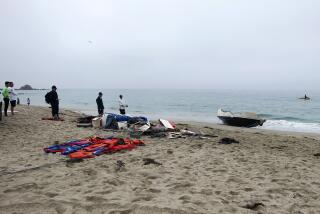It’s left to the state when a skipper abandons ship
- Share via
SEATTLE — Most boats start out as someone’s dream: the tugboat that can be restored and lived on, the fishing boat that represents a chance to make a living on the water.
“Men have pipe dreams. They buy a boat at an auction that just needs some work,” said harbormaster Robin Leraas, who runs the Westport Marina on Washington’s coast. “Then they get the first month’s moorage bill, and we don’t see them again.”
In many of the picturesque scenes of sparkling vessels moored at marinas and harbors up and down the West Coast, there is an abandoned boat. More than merely an eyesore, the derelict boat can be a fuel spill waiting to happen or, if it sinks, an underwater hazard.
In Washington state, officials estimate that 100 boats are abandoned every year. The state’s Derelict Vessel Removal Program has removed more than 250 boats from the state’s waterways since it was first funded in 2003, and the Legislature recently doubled the amount of money it will spend to find and dispose of them.
“You ask anyone who manages a marina pretty much anywhere in the country, and they’ll tell you they have a least one boat they are keeping an eye on,” said Doug Helton, director of the National Oceanic and Atmospheric Administration’s abandoned vessel program. He said it was impossible to estimate the size of the problem nationwide.
Boats are abandoned for any number of reasons. Storm damage is one, particularly in the Gulf Coast, where frequent hurricanes have amounted to the loss of many boats, both commercial and recreational. Florida alone estimates that more than 800 derelict boats litter its coastline.
It can be an industry shift, such as the reduction of the salmon fishing fleet in the Northwest, or a change in an owner’s physical health.
Sometimes the boat is set adrift, or an aging anchor line fails. The cabin cruiser that hasn’t left its slip in 10 years sinks in the marina.
These boats are usually in such poor condition that they can’t be sold, and high salvage costs discourage owners from disposing of the boats properly. So the problem is left to public officials.
Keeping track of derelict boats is a constant game of catch-up, said Melissa Montgomery, who heads Washington’s program, which is run by the state’s Department of Natural Resources, or DNR.
The state has 162 boats listed for removal. Twenty have already been cleared away this year, including four listed as top priority -- potential hazards to human health or safety.
All four of those vessels were aging fishing boats left to fall apart at the Westport Marina.
“Without the state program, we would have had to space it out, maybe remove one every other year,” said Leraas, the harbormaster.
The four boats ranged in size from 32 feet to 52 feet. Leraas estimates that each cost about $6,000 to remove. The cost goes up for vessels that sink.
“We’re a small town, a small marina. We just don’t have that kind of money. Without DNR, we’d have had to gamble on which one was likely to do the most damage when it sank,” she said.
Under Washington’s program, the state will reimburse up to 90% of the removal costs. Removing boats is complicated, for jurisdictional and legal reasons. The state requires local agencies to attempt to locate the vessels’ owners, and outlines the steps required for an agency to take possession of a boat.
Many states have legislation regarding derelict vessels, but a survey released by NOAA last year showed that only five states -- Washington, Oregon, California, Maryland and Mississippi -- consistently fund their programs.
California’s program is run by the Department of Boating and Waterways, which deals out grants to state and local agencies. Unlike Washington, California does not directly participate in the investigation or removal process.
Last month, the Legislature in Washington increased the abandoned vessel program’s budget by more than 50% to $1 million annually. That increase brings Washington’s funding in line with California’s, the highest in the nation.
“We’ve made a lot of headway in the last three years,” says Washington state Sen. Phil Rockefeller, sponsor of the legislative effort. “But to deal with the backlog of such vessels, it’s clear we need to expand the program.”
California is examining ways to curb boat abandonment. Some of the options being studied include stiff penalties for boat owners and the possible creation of a recreational vessel turn-in program.
Lt. Cmdr. Marty Smith, chief of incident management for the U.S. Coast Guard’s Seattle sector, estimates that about a third of the calls his crews respond to in any given year are about problems caused by derelict craft.
“There’s an old adage about boats: Recreational boats are holes in the water in which you throw money,” Smith said.
“People just don’t realize what they are getting into when they buy a boat -- how much maintenance, how much time, all of those factors. It’s a big commitment. They get in over their heads quickly.”
More to Read
Sign up for The Wild
We’ll help you find the best places to hike, bike and run, as well as the perfect silent spots for meditation and yoga.
You may occasionally receive promotional content from the Los Angeles Times.






